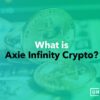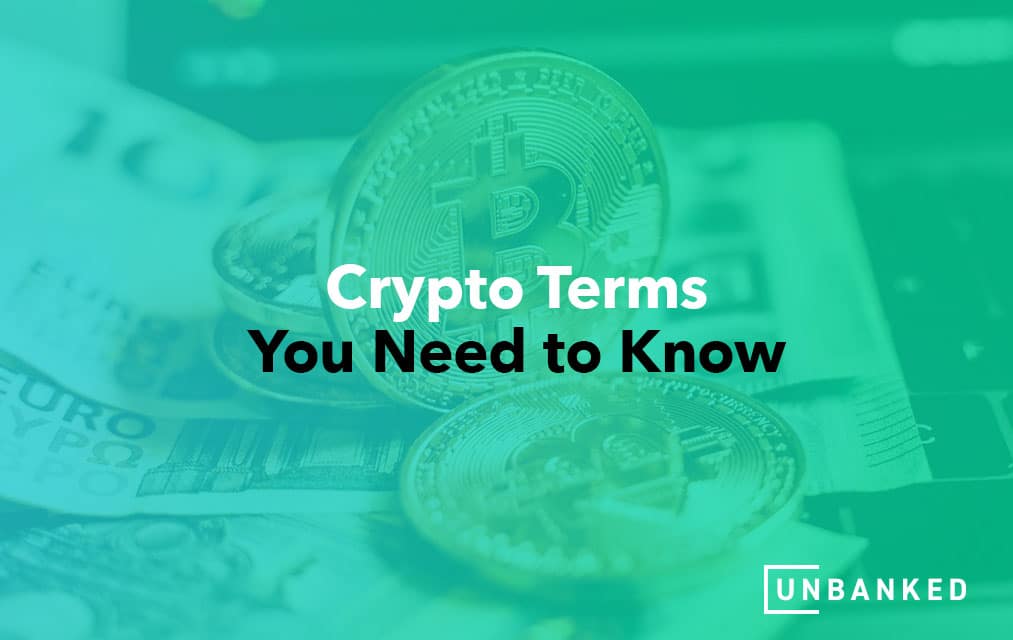Cryptocurrencies are not only an investment option different from traditional investment methods, but it also provides enormous profit opportunities for investors.
However, as with any investment, it is essential to understand what you invest in before getting started precisely. That is especially true when it comes to growth assets like cryptocurrencies.
Today, Unbanked will introduce you to some standard cryptocurrency terms and phrases to help newbies quickly get acquainted with the fascinating world of crypto.
ASIC
ASIC is an acronym that stands for an application-specific integrated circuit. ASIC uses an integrated circuit (IC) chip customized for a particular use rather than focusing on those general usages. In the cryptocurrency world, an ASIC is an expensive and powerful computing device that is used for mining cryptocurrency coins.
Bitcoin
On January 3, 2009, the first and most valuable cryptocurrency, BITCOIN, was released.
While its value has consistently increased, it has experienced violent swings.
Bitcoin’s price has swung from a record high of $60,000 down below $30,000 in just a few months.
Altcoin
Any coin that isn’t Bitcoin is known as an altcoin.
Altcoins range from Ethereum, the second most popular cryptocurrency, to thousands of coins with low market value.
According to experts, you should focus your investment on the more well-known, major cryptocurrencies.
Bitcoin Cash
A fork of the original Bitcoin that created a peer-to-peer electronic cash system.
Whereas Bitcoin is commonly seen as being too volatile to be usable as a currency, Bitcoin Cash is intended to be more transaction-friendly.
Whale
A “whale” is a person or entity that holds a significant amount of cryptocurrency.
Whales can greatly impact the market since they can buy and sell massive amounts of a coin, causing prices to skyrocket or plummet.
When trading, it’s critical to be mindful of whales, as they can frequently swing the market in their favor.
If it is revealed that a whale is selling a huge number of Bitcoin, the price of Bitcoin may begin to plummet.
DAO
A Decentralized Autonomous Organization (DAO) is an organization that is run by code rather than humans.
Decentralized autonomous organization is abbreviated as “DAO.”
A decentralized autonomous organization (DAO) aspires to be decentralized and autonomous, meaning it can operate independently of any central authority.
ATH
The abbreviation “ATH” stands for “all-time high.” This word refers to the highest price that a particular cryptocurrency has ever achieved.
“Bitcoin has hit an ATH,” you might say if Bitcoin sets a new all-time high of $69,000.
Coinbase
This is a well-known centralized cryptocurrency exchange.
Coinbase was the first cryptocurrency exchange to go public on the Nasdaq, making history.
Cold Wallet/Cold Storage
A cold wallet or cold storage is a safe and secure way to keep your cryptocurrency offline.
Many cold wallets, commonly known as hardware wallets, are physical devices that resemble USB drives in appearance.
This type of wallet can help safeguard your cryptocurrency from hacking and theft, but it also has drawbacks, such as the possibility of losing it and your cryptocurrency.
Cryptocurrency
Cryptocurrency is a decentralized and digital kind of currency.
This type of currency can be used to buy and sell products as well as to store value.
Cryptography
This process hides or codes information so only the intended person can read or view the message. The art of cryptography has been used to code secret messages for thousands of years. Cryptography secures computer passwords, bank cards, and crypto-wallets. This information is scrambled and can only be decrypted and read with a private key.
Decentralization
Decentralization is the principle of distributing power away from a central point.
In contrast to a central authority, blockchains are usually decentralized since they require majority approval from all users to operate and make modifications.
Decentralized Finance (DeFi)
Decentralized financial transactions are carried out without a middleman, such as a bank, government, or other financial organization.
Decentralized Applications (DApps)
To carry out tasks without intermediaries, developers create and deploy blockchain applications.
Decentralized apps (DApps) are frequently used to fulfill decentralized finance tasks.
Ethereum is the most popular network for decentralized finance activity.
Distributed Ledger
In the world of traditional finance, an organization, such as a bank, will hold a ledger of all those customer transactions. These distributed ledgers use nodes, known as independent computers. The computers will share, record, and synchronize the transaction across the electronic ledger. In cryptocurrency, a blockchain is considered a type of distributed ledger.
The participants can assess distributed ledgers at each network node. With that, the participants can obtain a copy of the records on the network. If the ledger is edited, the changes are replicated and sent to the participants. All information across the database is synchronized. Both Bitcoin and distributed lenders use the same technology.
Double Spend
When you spend $5 in cash, you no longer own that money and cannot spend it for a second time. With digital transactions, all centralized authorities, like banks, permit their customers to spend money one transaction at a time. However, with those decentralized financial tokens, such as cryptocurrency, a single coin may be copied over 100 times and even spent 100 times.
As you may have guessed, that can cause issues for the market. A blockchain is able to solve and prevent the problem of double spending from occurring.
Digital Gold
Experts frequently compare cryptocurrencies to real gold in terms of their ability to store and increase value.
Bitcoin is referred regarded as “digital gold” by many people.
Unbanked’s financial professionals are excited to offer a wide range of modern solutions for modern challenges in order to provide clients with a completely different banking experience! Get in touch with them today!
Ethereum
Ethereum is a crypto network and software platform that developers may use to construct new applications, and it has an associated currency called ether.
Ethereum is the second largest cryptocurrency by trade volume.
Exchange
A digital marketplace where you may buy and sell bitcoin is known as a cryptocurrency exchange.
Encryption
Securing digital information into a form that prevents unauthorized access is known as encryption. When you use a password or key to access a website, the information is encrypted so hackers cannot steal it. Encryption is related to cryptography, which is the practice of protecting sensitive data.
Blockchain encryption allows two parties to share their information without needing a centralized government or bank. Different types of cryptocurrencies will use different types of encryption.
Secret Key Encryption
If the users have the same keys for encrypting and decrypting, that is known as symmetric encryption. The key in this cryptographic system might be referred to as the “common key,” which is used to both decrypt and encrypt data. With these systems, there is a greater chance of a security breach.
Public Key Encryption
On the other hand, an asymmetric system will use two separate keys – public and private keys. The Bitcoin network does use an asymmetric approach. Its users are issued a public key, and then the system will generate a private one. The asymmetric encryption system issues a public key that can encode or encrypt data. However, a user would need a private key to decode or decrypt. Think of it this way: the public key turns the plaintext into ciphertext, with the private key putting that into reverse.
Hashing
With hashing, this system does not use keys at all. This type of encryption will use an algorithm to generate a “hash value” based on the input. Hash functions are considered secure since these values are constantly generated, making them almost impossible for the plaintext to be decrypted. The process of hashing is complicated, which makes it an excellent method of mining cryptocurrencies. Those computational resources used on the network contributed to the process known as the hash rate. When there is a good hash rate, the network is very secure.
Hash
A hash is a unique string of numbers and letters that identifies blocks and is tied to crypto buyers and sellers.
Block
Blocks are groups of data within a blockchain.
Cryptocurrency blockchain blocks are made up of transaction records that demonstrate how users buy and sell currencies.
Each block can only carry a limited amount of data. A new block is produced to continue the chain once it reaches that limit.
Blockchain
The underlying technology is underpinning cryptocurrency and a digital type of record keeping.
A blockchain is made up of sequential blocks that build on top of each other to form an immutable and permanent register of transactions.
There are 4 kinds of blockchains structures:
- Public
- Private
- Hybrid
- Consortium
Coin
A representational store of digital value is on a specific blockchain or cryptocurrency network.
Some blockchains, such as Bitcoin, use the same name for both the network and the coin.
Others, such as the Stellar blockchain, which has a native coin called Lumen, can have other names.
Hot Wallet
A hot wallet is a bitcoin wallet that is software-based and connected to the Internet.
While digital wallets are handier for accessing your cryptocurrency rapidly, they are more vulnerable to hacking and cybersecurity assaults than offline wallets.
Similarly, files stored in the cloud may be more easily hacked than those kept in a home safe.
Initial Coin Offering (ICO)
ICO is a method of raising funding for a new cryptocurrency project.
Initial Public Offerings (IPOs) of stocks are comparable to ICOs.
Kimchi Premium
This term is the gap in cryptocurrency prices found on the South Korean exchanges. The price of Bitcoin is the most affected by this difference. On South Korean exchanges, the price of Bitcoin might be higher than those changes in Europe or the United States. The name “kimchi premium” refers to a popular cabbage dish in Korean cuisine. Over the years, the South Korean government has tried to regulate prices on the exchange despite a growing demand from investors.
Market Capitalization
Cryptocurrency market capitalization refers to the total worth of all the coins that have been mined.
A cryptocurrency’s market cap is determined by multiplying the current number of coins by their current value.
Mining
Crypto mining is a method by which new cryptocurrency coins are made available, and a log of user transactions is kept.
Node
A computer that connects to a distributed log network.
Non-fungible Tokens (NFTs)
Non-fungible tokens are value units used to represent ownership of one-of-a-kind digital objects such as artwork or collectibles.
The Ethereum blockchain is where most NFTs are stored.
Peer-to-peer
This is when two users interact directly without a third party or intermediary.
Public Key
The address on your wallet is comparable to the number on your bank account.
After you authorize it, you can share your public wallet key with people or institutions so they can send you money or withdraw money from your account.
Private Key
Direct access to your bitcoin is possible thanks to the encrypted code, which is called a private key.
Your private key, like your bank account password, should never be shared.
Satoshi Nakomoto
Bitcoin’s pseudonymous founder.
No one knows who Satoshi Nakomoto is or if he is more than one person.
Smart Contract
Smart contracts are algorithmic programs that enact the terms of a contract based on its code.
The capacity to execute smart contracts is one of the Ethereum network’s core value propositions.
Stablecoin or Digital Fiat
A stablecoin is one whose value is linked to that of another non-digital currency or commodity, like gold.
On the blockchain, a digital fiat represents a fiat or government-backed money.
Tether is one example of this, pegged to the US dollar.
Fork
When the blockchain users make changes to its rules, the protocol of the blockchain typically results in two new paths: one that follows the old rules and another that branches off from the prior one. This is what we call a fork in cryptocurrency.
Bitcoin Cash, derived from Bitcoin, is an excellent illustration of this.
Gas
To use the Ethereum network, developers must pay a fee to the Ethereum network.
Gas is paid in ether, Ethereum’s native money.
Genesis Block
The Genesis Block is the name given to the very first bitcoin block ever mined.
HODL
Though the name originated from a user error on a Bitcoin forum in 2013, it stands for “Hold On for Dear Life” or HODL for abbreviation.
It’s a passive investing approach in which consumers buy and hold cryptocurrencies rather than trading them in hopes of seeing their value rise.
Halving
Bitcoin’s code includes a function that reduces the quantity of new Bitcoin entering circulation once a specific number of blocks are mined, which is typically around every four years.
For example, Bitcoin’s price may be affected by halving. This is what is called “Bitcoin halving.”
Token
“Token” is frequently used as a synonym for “cryptocurrency” in the cryptocurrency world.
The terms “cryptocurrency token” and “cryptocurrency” are frequently used interchangeably.
Vitalik Buterin
Vitalik Buterin is the programmer that invented Ethereum in 2015.
Wallet
A crypto wallet is where you can keep your cryptocurrency. Digital wallets are available on several exchanges.
Wallets can be either hot (Internet, software-based) or cold (offline, hardware-based).
High-Frequency Trading
High-frequency trading, or HFT for short, is a type of trading that uses modern computer systems to execute massive orders in seconds.
These systems employ complex algorithms to analyze numerous markets and execute orders following market conditions.
This trading approach has advantages and disadvantages, which you can learn more about as you go deeper into the subject.
DEX
DEX stands for Decentralised Exchanges, which allow users to swap coins and tokens without the necessity of a centralized intermediary by utilizing smart contracts and blockchain technologies.
You are free to keep custody of your funds and private keys in whichever manner you see appropriate for your investing objectives.
DEXs are also thought to be less vulnerable to cyber-attacks than centralized intermediaries.
Crypto Exchange
A digital currency exchange (DCE) or crypto exchange is a digital marketplace where you may buy, sell, or trade cryptocurrencies.
You’ll need to register an account on a crypto trading site to convert your US dollars (or other cash) into digital assets.
Paper Wallet
A paper wallet is a type of cold storage in which your public and private keys are printed out (usually on paper).
GameFi
GameFi blends gaming (gaming) and money (finance). It’s a website where people can get money by playing games.
GameFi is not confined to any one technology or platform because it encompasses a wide range of games, rules, and structures.
Address
For bitcoin transactions, a wallet address is a string of letters and digits that serves as an account number.
Addresses can be shared with the general public.
Because network-specific addresses differ, each crypto asset needs its address.
Coin Burning
Miners and developers remove coins from circulation by burning them. In other words, burning coins destroys the coin and prevents it from being used in future transactions.
Developers and miners will transmit bitcoin to specific addresses with non-public private keys.
Liquidity
Liquidity refers to how easily a crypto asset may be converted into cash or another item.
The influence of liquidity on the value of your assets will determine whether they are devalued or not.
Meme Coin
Meme coins are cryptocurrencies inspired by popular social media jokes, sarcasm, or puns.
The first meme coin created was Dogecoin (DOGE).
Meme coins tend to be highly volatile.
They are mainly community-driven and can gain popularity overnight due to online community endorsements and FOMO.
Still, their price can also slump unexpectedly when traders turn their attention to the next meme coin.
Ecosystem
A cryptocurrency or blockchain ecosystem is a collection of projects that can interact with one another and the rest of the world to build a transaction environment with all of the features needed to meet user needs.
These projects will be diverse and complement one another to assist the ecosystem’s development.
Transactions and payments, DeFi decentralized finance, social and entertainment, and other components are common in a whole ecosystem.
Algorithm
An algorithm uses a sequence of instructions to process data or perform a calculation. To produce the desired result, the user must follow these instructions in the correct order. There are many types of crypto algorithms in the crypto world.
These algorithms play a crucial role in managing the security of the blockchain and verifying those transactions. Without algorithms, crypto mining would not be possible. Along with that, the blockchain would be prone to security problems. However, there are three classes that the National Institute of Standards and Technology (NIST) has approved. They include:
Hash Function
A cryptographic hash function does not use keys to perform an essential operation. This function will create a hash value containing a large amount of data. Users can use the hash function to build blocks in the chain. Plus, they are used to secure the network. If there is a need to generate or verify a digital signature, hash functions are used to compress those pieces of data. Hash functions are also employed to create message authentication codes (MACs). Additionally, hash functions can make deterministic random numbers and generate keys for other key-based algorithms.
Symmetric-Key Algorithm
They can help transform data, making it hard to decode with the secret key. Many people will use a symmetric-key algorithm for decryption and encryption. Several individuals can use these keys as long as they have authorization. Additionally, these algorithms can provide source attribution for MACs and keep confidential data secured since the same key is used for decrypting and encrypting information. These algorithms establish keys during the establishment phase and generate those deterministic random numbers.
Asymmetric-Key Algorithm
To solve these algorithms, the user needs a private and public key. A public key can be known to several parties, but the owners have total access to the private key. Even if the private and public are at the exact location, they cannot be deciphered together. Asymmetric-key algorithms can establish cryptographic keying materials and identify digital signatures.
Final Thoughts on Crypto Terms
There you have it. Here are the most commonly used crypto terms up-to-date. Knowing these terms will give you a better understanding of the cryptocurrency market.
Looking for a way to buy, sell, and manage your cryptocurrency? Unbanked offers various high-quality services to assist you in safely investing in digital assets! Contact us today!





